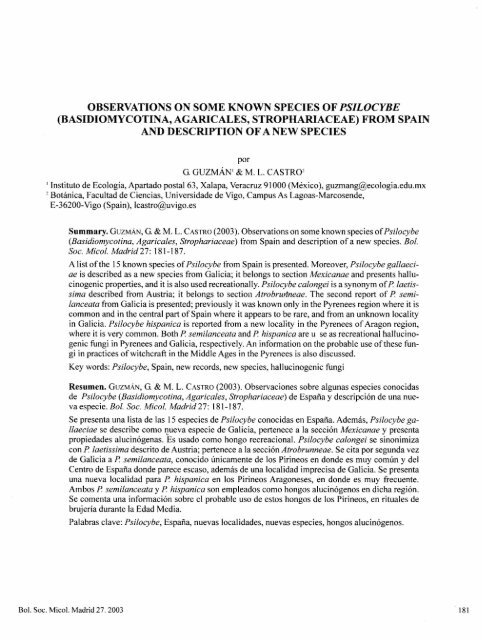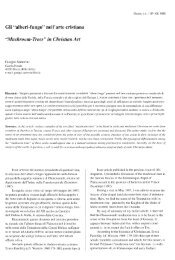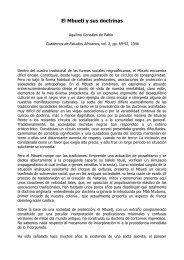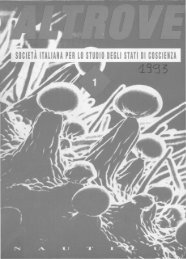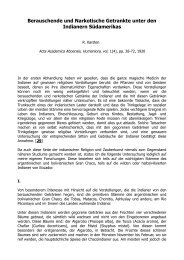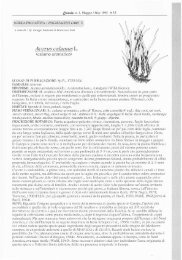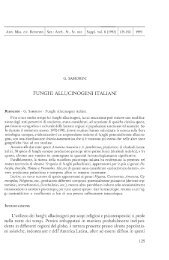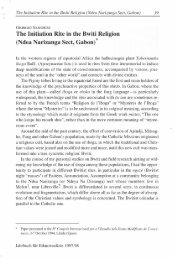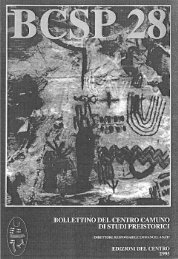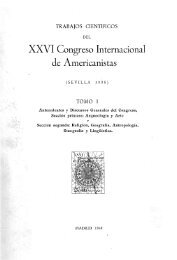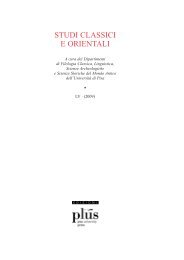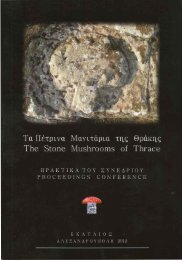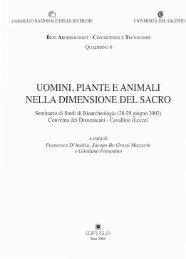OBSERVATIONS ON SOME KNOWN SPECIES OF PSILOCYBE ...
OBSERVATIONS ON SOME KNOWN SPECIES OF PSILOCYBE ...
OBSERVATIONS ON SOME KNOWN SPECIES OF PSILOCYBE ...
Create successful ePaper yourself
Turn your PDF publications into a flip-book with our unique Google optimized e-Paper software.
<strong>OBSERVATI<strong>ON</strong>S</strong> <strong>ON</strong> <strong>SOME</strong> <strong>KNOWN</strong> <strong>SPECIES</strong> <strong>OF</strong> <strong>PSILOCYBE</strong><br />
(BASIDIOMYCOTINA, AGARICALES, STROPHARIACEAE) FROM SPAIN<br />
AND DESCRIPTI<strong>ON</strong> <strong>OF</strong> A NEW <strong>SPECIES</strong><br />
por<br />
G. GUZMAN' & M. L. CASTRO '<br />
1 Instituto de Ecologia, Apartado postal 63, Xalapa, Veracruz 91000 (Mexico), guzmang@ecologia.edu.mx<br />
2 Botanica, Facultad de Ciencias, Universidade de Vigo, Campus As Lagoas-Marcosende,<br />
E-36200- Vigo (Spain), lcastro@uvigo.es<br />
Summary. GuzMAN, G. & M. L. CASTRO(2003). Observations on some known species of Psilocybe<br />
(Basidiomycotina, Agaricales, Strophariaceae) from Spain and description of a new species. Bol.<br />
Soc. Micol. Madrid 27: 181-187.<br />
A list of the IS known species of Psilocybe from Spain is presented. Moreover, Psilocybe gallaeciae<br />
is described as a new species from Galicia; it belongs to section Mexicanae and presents hallucinogenic<br />
properties, and it is also used recreationally. Psilocybe calongei is a synonym of P laetissima<br />
described from Austria; it belongs to section Atrobrunneae. The second report of P semilanceata<br />
from Galicia is presented; previously it was known only in the Pyrenees region where it is<br />
common and in the central part of Spain where it appears to be rare, and from an unknown locality<br />
in Galicia. Psilocybe hispanica is reported from a new locality in the Pyrenees of Aragon region,<br />
where it is very common. Both P semilanceata and P hispanica are u se as recreational hallucinogenic<br />
fungi in Pyrenees and Galicia, respectively. An information on the probable use of these fungi<br />
in practices of witchcraft in the Middle Ages in the Pyrenees is also discussed.<br />
Key words: Psilocybe, Spain, new records, new species, hallucinogenic fungi<br />
Resumen. GuzMAN, G. & M. L. CASTRO(2003). Observaciones sobre algunas especies conocidas<br />
de Psilocybe (Basidiomycotina, Agaricales, Strophariaceae) de Espafia y descripcion de una nueva<br />
especie. Bol. Soc. Micol. Madrid 27: 181-187.<br />
Se presenta una lista de las IS especies de Psilocybe conocidas en Espafia. Ademas, Psilocybe gallaeciae<br />
se describe como '2ueva especie de Galicia, pertenece a la seccion Mexicanae y presenta<br />
propiedades alucinogenas, Es usado como hongo recreacional. Psilocybe calongei se sinonimiza<br />
con P laetissima descrito de Austria; pertenece a la seccion Atrobrunneae. Se cita por segunda vez<br />
de Galicia a P semilanceata, conocido unicamente de los Pirineos en donde es muy cornun y del<br />
Centro de Espafia donde parece escaso, ademas de una localidad imprecisa de Galicia. Se presenta<br />
una nueva localidad para P hispanica en los Pirineos Aragoneses, en donde es muy frecuente.<br />
Ambos P semilanceata y P hispanica son empleados como hongos alucinogenos en dicha region.<br />
Se comenta una inforrnacion sobre el probable uso de estos hongos de los Pirineos, en rituales de<br />
brujeria durante la Edad Media.<br />
Palabras clave: Psilocybe, Espafia, nuevas localidades, nuevas especies, hongos alucinogenos.<br />
Bo!. Soc. Mico!. Madrid 27.2003 181
G GUZMAN & M. L. CASTRO<br />
INTRODUCTI<strong>ON</strong><br />
The genus Psilocybe has received little attention<br />
in studies on Spanish fungi. There are only 15<br />
known species, one of them endemic: P hispanica<br />
Guzrnan (2000), known only from Aragon. The<br />
other known species are: P calongei Moreno &<br />
Esteve-Raventos (1988) from Madrid, also reported<br />
by ILLA A & al. (1989); P coprophila (Bull. :<br />
Fr.) P. Kumm. from Corufia (FREIRE, 1982;<br />
CASTRO& FREIRE, 1982; CASTRO, 1985); P crobula<br />
(Fr.) M. Lange [as P inquilina var. crobula (Fr.)<br />
Hoilland] from Malaga (ORTEGA & al., 1996); P<br />
cyanescens Wakef. (STAMETS, 1996; GuzMAN &<br />
al., 1998; reported not confirmed); P liniformans<br />
Guzman & Bas from Vizcaya (FERNANDEZ-SASIA,<br />
2001); P luteonitens (Vahl.: Fr.) Parker-Rhodes<br />
from Catalufia and Galicia (MORE 0 & al., 1986)<br />
and Corufia (FREIRE, 1982; CASTRO, 1985;<br />
MORENO & al., 1986); P merdaria (Fr.) Ricken<br />
from Huelva (CAL<strong>ON</strong>GE& TELLERiA, 1980), Salem<br />
and Belgida (MALEN
<strong>SPECIES</strong> <strong>OF</strong> <strong>PSILOCYBE</strong><br />
IN SPAIN<br />
I<br />
Figs. 1-9.- \-2. Psilocybe semilanceata, I: spores, 2: cheilocystidia (both from J. Comesaha "A"). 3-5. P hispanica, 3: spores,<br />
4: pleurocystidia, 5: cheilocystidia (all from 1. Seral-Bozal s.n.). 6-9: Psilocybe gallaeciae, 6, 7, 8: spores; 9: basidia (6, 9: F<br />
Valeiras "B"). Scale bar I0 urn.<br />
Bol. Soc. Micol. Madrid 27. 2003 183
G. GUZMAN & M. L. CASTRO<br />
I<br />
Figs. 10-15. Psilocybe gallaeciae, 10-11: pleurocystidia; 12-15: cheilocystidia (10, 13; holotype; 11-14: F Valeiras "A"; 12, 15:<br />
F Valeiras "B"). Scale bar 10 urn<br />
184 Bol. Soc. Micol. Madrid 27. 2003
<strong>SPECIES</strong> <strong>OF</strong> <strong>PSILOCYBE</strong><br />
IN SPAIN<br />
... hyphae ..., no subcellular elements present". On<br />
the other hand, MORENO& ESTEvE-RAVENTOS<br />
(1988) described the subpellis as "whith subsphaerical<br />
to broadly cylindrical, clamped hyphae,<br />
-15 (-20) urn diam ... ". It is probable that the "subpellis"<br />
of these last authors is actually the context,<br />
named trama by HAUSKNECHT& SINGER(1986),<br />
that they described as having thick clamped hyphae.<br />
It is concluded that P laetissima is the correct<br />
name of the Spanish fungus. Psilocybe laetissima<br />
was described from the region of Vienna, and<br />
according to the form of the thick-walled spores,<br />
non-staining basidioma and the poor development<br />
veil, the species belongs to the section<br />
Atrobrunneae Guzrnan (GuzMAN, 1983, 1995).<br />
A new locality of Psilocybe semilanceata (figs.<br />
1-2).<br />
This fungus was known only from the Pyrenees<br />
region (Navarra, Aragon and Catalonia) although<br />
BECKER(1989) and MORENO& al. (1986) also reported<br />
it from the central part of Spain, where it<br />
seems to be rare. Psilocybe semilanceata grows on<br />
soil in alpine meadows, at 1600-2200 m altitude,<br />
where it is very common. In the Huesca alpine<br />
meadows (Pyrenees of Aragon), P coprophila, P<br />
hispanica and P luteonitens are also common.<br />
It is presented here the second record of P<br />
semilanceata in Galicia, now from Pontevedra,<br />
Nigran, Chandebrito, with several specimens<br />
gathered by J. Comesafia, on 28 November 1997<br />
(XAL). Previously it was reported by FREIRE& al.<br />
(1994) from Galicia but without locality. The material<br />
now studied agrees well with the concept of<br />
P semilanceata according to GuzMAN(1983). The<br />
spores are (10-) 11-14 (-15) x (6.5-) 7-8 urn and<br />
the cheilocystidia 21-32 (-34) x,5.5-7 (-8) urn,<br />
many of them irregularly branched.<br />
A new locality of Psilocybe hispanica<br />
This species was known only from the type locality<br />
in the Pyrenees of Aragon, in the north of<br />
Huesca, on horse dung, in an alpine meadow at<br />
2300 m altitude (figs. 3-5).<br />
It is reported here the second locality of P hispanica<br />
in Aragon: Huesca, Tramacastillo de Tena,<br />
October 1999,1. Seral-Bozal (XAL). The studied<br />
material agrees well with the type in all the mean<br />
features, except in the pleurocystidia (see below).<br />
It presents a spore print black violet, spores (11-)<br />
12-14.5 (-15) x 6.5-8/lm; cheilocystidia (16-) 18-<br />
26 (-28) x 5.5-7 urn, many of them irregularly<br />
branched; pleurocystidia rare, 10-20 x 7-9 urn,<br />
hyaline, irregularly lageniform with a short neck<br />
or irregularly utriform, with or without a papilla;<br />
the pleurocystidia were not reported in the type<br />
description (GuzMAN, 2000). It grows gregarious<br />
abundantly on horse dung, sometimes producing<br />
more than 25 basidiomata on the same dung. In the<br />
field, it is distinguished from P coprophila by the<br />
bluing stipe. Psilocybe hispanica is very common<br />
in all the alpine meadows of the Pyrenees, at 1700-<br />
2300 m altitude, and has also penetrated the<br />
French part of the Pyrenees.<br />
Psilocybe gallaeciae<br />
novo(figs. 6-15)<br />
Guzman & M.L. Castro sp.<br />
Pileo (5-) 10-20 mm lato in sicco, convexus vel<br />
campanulatus, subpapillato, rufobrunneo vel aurantio-brunneo,<br />
vel nigrello, higrophano.<br />
Lamellis adnatis vel subadnatis, rufobrunneus<br />
cum tinctus violaceus, marginis albidus. Stipe 30-<br />
55 x 1-2 mm in sicco, cum pseudorhiza ad -5 mm<br />
longe, brunneolo vel pileo concolore. Sporis (8.5-<br />
) 9.5-11 (-13) x (6-) 7-7.5 (-9) x 5.5-6.5 (-7) pm,<br />
oblonguisis in facies, subrhombicis in frons.<br />
Pleurocystidiis (11-) 14-19 (-21.5) x 5-8 (-9) pm,<br />
hyalin is, lageniformis vel late. Cheilocystidiis<br />
(15-) 17-30 (-40) x (4-) 5-8 (-12) pm, hyalin is, auguste<br />
lageniformis, naequalitis ramosis.<br />
Subhymenium cellularis. Trama subregular.<br />
Pilleipellis quam ixocutis. Subpellis subcellularis.<br />
Ad terram, graminicola. Hispania, La Coruha,<br />
Mo nfero, Caaveiro, 23-XI-1997. Typus J.<br />
Comesaiia "C" (XAL), isotypus MA-Fungi<br />
56866; LOU-Fungi 17969).<br />
Pileus (5-) 10-20 mm diam (in dry specimens),<br />
convex to subcampanulate, with a short conic<br />
papilla, smooth to sulcate-striate in dry, sometimes<br />
irregularly ondulate or plicate at the margin,<br />
brown reddish (7C7-8 or 9F6-8) or brown<br />
orangish (805-7), hygrophanous to beige brown<br />
(604-5) toward the margin, in dry specimens<br />
blackish brown (9F4-5 or more black), with the<br />
center blackish red (1008 or 10E8). Lamellae adnate<br />
or subadnate, thin, brown reddish violet<br />
Bo!. Soc. Mico!. Madrid 27. 2003<br />
185
G. GUZMAN & M. L. CASTRO<br />
(lOE4-5), with edges whitish and even. Stipe<br />
30-55 x 1-2 mm in dry specimens, with a long<br />
pseudorhiza up to 5 mm long, uniform or slightly<br />
thick toward the base before the pseudorhiza or<br />
subbulbose, brownish pale (4A3-4) to brown reddish<br />
(7C8) or blackish (10F4-6), bluing, with<br />
white mycelium covering the base, hollow,<br />
smooth, but surface fibrillose. Veil non in the<br />
adults. Context concolorous with pileus whitish<br />
below. Odor and taste not checked, probably farinaceous.<br />
Spore print violet black.<br />
Spores (8.5-) 9.5-11 (-13) x (6-) 7-7.5 (-9) x<br />
5.5-6.5 (-7) urn, compressed, in face-view oblong<br />
or subellipsoid, in frontal-view subrhomboid,<br />
thick-walled, brown yellowish with a conspicous<br />
germ pore. Basidia (19-) 20-28 (-33) x<br />
(7-)8-9.5 urn, 4-spored, hyaline, subcylindrical,<br />
with a median constriction. Pleurocystidia (J 1-)<br />
14-19 (-21.5) x 5-8 (-9) urn, hyaline, common,<br />
lageniform or broadly lageniform, with the neck<br />
short or up to 8 urn long. Cheilocystidia (15-) 17-<br />
30 (-40) x (4-) 5-8 (-12) urn, hyaline, common,<br />
narrowly lageniform, frequently irregularly<br />
branched with two or three necks, up to 15 urn<br />
long. Subhymenium cellular, with hyaline and<br />
smooth to encrusted of brown yellowish pigment,<br />
3-8 urn wide elements. Trama subregular,<br />
with hyaline, cylindrical to inflated hyphae, 3-30<br />
urn wide, some of them encrusted by brown yellow<br />
pigment. Pileipellis an ixocutis 16-24 urn<br />
thick, with 1.5-5 urn wide, hyaline. Subpellis<br />
(hypopileipellis) hyaline to encrusted of brown<br />
yellowish pigment, slightly cellular, with hyphae<br />
2-4 urn wide and inflated elements 8-10.5 urn<br />
wide. Clamp connections common.<br />
Habitat and distribution. Gregarious in soil, in<br />
grassland and gardens. Known only from Galicia,<br />
Spain, where it is common.<br />
Studied material. SPAIN, La Corufia, Monfero,<br />
Caaveiro, 23 November 1997, 1. Comesaha "C"<br />
(holotype XAL, isotype MA-Fungi 56866, LOU-<br />
Fungi 17969). Pontevedra, Vigo, 5 November<br />
1999, J. Perez (LOU-Fungi 17970; XAL); F<br />
Valeiras "B" (LOU-Fungi 17968; XAL); Campus<br />
Universitario, As Lagoas-Marcosende, 6 October<br />
2000, I. Otero & J.M Perdiz (LOU-Fungi 17967;<br />
10 October 200 1,1. Granda (LOU-Fungi 17972);<br />
5 November 1999, F Valeiras "A" (XAL); Nigran,<br />
Chandebrito, 23-28 November 1997,1. Comesaha<br />
"8" (XAL); 5 November 1999, F Valeiras "A"<br />
(XAL); Gondomar, Pinzas, Donas, 9 November<br />
2001, X. Bellon et al. (LOU-Fungi 17971);<br />
November 2000, A. Lorenzo-Garcia 2 (XAL);<br />
Grove, October 2000, 1. Seral-Bozal (XAL);<br />
Pontevedra, without locality, October 1998,1. Ott<br />
98-002 (XAL).<br />
Psilocybe gallaeciae belongs to section<br />
Mexicanae Guzman, following GUZMAN (1983)<br />
for the form and size of their thick-walled spores,<br />
and its bluing basidioma. For the pseudorhiza it is<br />
closely related to P galindii, GUZMAN (1983)<br />
from Mexico and P antioquensis, GUZMAN & at<br />
(1994) from Colombia, but those species have<br />
cheilocystidia 14-19 urn long and 15-20 urn long,<br />
respectively. Psilocybe mexicana R. Heim has neither<br />
pseudorhiza nor pleurocystidia, and it is<br />
known only from Mexico and Guatemala. This is<br />
the first record of a species of the section<br />
Mexicanae found in Europe. Their members are<br />
known from Mexico, U.S.A. (Florida), Colombia,<br />
Brazil and Thailand (GUZMAN, 1995). The local<br />
Galician people use P gallaeciae recreationally<br />
for its hallucinogenic properties. Psilocybe serbica<br />
reported by FREIRE& al. (1994) from Galicia,<br />
without any description, probably is P gallaeciae.<br />
Psilocybe serbica belongs to section<br />
Semilanceatae and it is known only from central<br />
Europa (GuzMAN, 1983).<br />
THE HALLUCINOGENIC <strong>SPECIES</strong><br />
From the 15 known species of Psilocybe in<br />
Spain, only P semilanceata, P hispanica and P<br />
gallaeciae have hallucinogenic properties. They<br />
are used as recreational by young people in the<br />
Pyrenees region and in Galicia. It is interesting to<br />
observe that in Valle de Tena, in the Pyrenees of<br />
Aragon, was found (Seral-Bozal, pers. comm ..) a<br />
medallion from the XVII Century, with a devil<br />
and some toadstools carved on it; the toadstools<br />
are related to hallucinogenic fungi, and may be<br />
belonging to P hispanica or P semilanceata.<br />
This is in relationship with the practicing of<br />
witchcraft, very common in that valley in the<br />
Middle Ages.<br />
186<br />
Bol. Soc. Micol. Madrid 27. 2003
<strong>SPECIES</strong> <strong>OF</strong> <strong>PSILOCYBE</strong> IN SPAIN<br />
ACKNOWLEDGEMENTS<br />
The authors acknowledge the help of Arturo<br />
Lorenzo Garcia from Pontevedra and Ignacio<br />
Seral Bozal from Huesca for gathering several<br />
specimens in their localities and for their information.<br />
Guzman acknowledge the help of his assistant<br />
Florencia Ramirez-Guillen for her help in the<br />
microscopic observations. He also thanks C<strong>ON</strong>A-<br />
CYT and SNI for the support of his research. M.<br />
Luisa Castro thanks her friends and students 1.<br />
Comesafia, F. Valeiras, 1. Perez, I. Otero, 1.M.<br />
Perdiz, X. Bellon, O. Alvarez, C. Covelo, D.<br />
Gonzalez and 1. Granda who gathered several of<br />
the fungi mentioned for this study. lonathan Ott<br />
also provided important fungus specimens.<br />
BIBLIOGRAPHY<br />
BECKER, G (1989). Setas. Susaeta, Madrid (second edition).<br />
CAL<strong>ON</strong>GE, F. D. & M.T. TELLERiA (1980). Introduccion al eonocimiento<br />
de los hongos de Dofiana (Huelva, Espafia).<br />
Lazaroa 2: 271-326.<br />
CASTRO, M.L. (1985). Macromicetos de pinares gal/egos.<br />
Imprenta Universitaria, Santiago de Compostela.<br />
CASTRO, M.L. (1995). Fragmenta chorologica occidentalia.<br />
Fungi 5323-5370. Anales Jard. Bot. Madrid 53: 103-105.<br />
CASTRO, M.L. & L. FREIRE (1982). Aportacion a los macrom<br />
icetos de los pi nares de Gal icia (Espafia). Trab.<br />
Compostelanos Bioi. 9: 97-137.<br />
CASTRO, M.L., A. Souso & L. FREIRE (1997). Fragrnenta<br />
chorologica occidentalia. Fungi 6084-6113. Anales Jard.<br />
Bot. Madrid 55: 442-444.<br />
FERNANDEZ-SASIA, R. (200 I). Aportacion al conocimiento de<br />
los macromicetos en el norte de la Peninsula lberica.<br />
Cortinariales I. Doc. Mycol. 31 (122): 35-55.<br />
FREIRE, L. (1982). Macromycetes de la "Selva Negra"<br />
(Santiago). Imprenta Universitaria, Santiago de<br />
Compostela.<br />
FREIRE, L., M.L. CASTRO & M. PEREZ (1994). Guia de las<br />
setas mas comunes de Galicia. Casa de las Ciencias.<br />
Santiago de Compostela.<br />
GARciA ROLLAN, M. (1971). Contribucion al conocimiento de<br />
las setas de la provincia de Orense y de sus posibilidades<br />
de aprovechamiento. Alimentaria 8 (39): 3-21.<br />
GuzMAN, G. (1983). The genus Psilocybe. Beih. Nova<br />
Hedwigia 74, Cramer, Vaduz.<br />
GuzMAN, G (1995). Supplement to the monograph of the genus<br />
Psilocybe. In: O. PETRINI & E. HORAK (eds.),<br />
Taxonomic Monographs of Agaricales. Bib!. Myco!. 159:<br />
91-141.<br />
GUZMAN, G. (2000). New species and new records of<br />
Psilocybe from Spain, the U.S.A. and Mexico, and a new<br />
case of poisoning by Psilocybe barrerae. Doe. Mycol. 29:<br />
41-52.<br />
GUZMA.N,G, l.W. ALLEN & J. GARTZ (1998). A worldgeographical<br />
distribution of the neurotropic fungi, an analysis<br />
and discussion. Ann Mus. Civico Rovereto 14: 189-280.<br />
GuzMAN, G, Y. SALDARRIAGA,F. PINEDA & L. F. VELASQUEZ<br />
(1994). New species of Psilocybe from Colombia and discussion<br />
of the know species. Mycotaxon 51: 225-235.<br />
HAUSKNECHT, A. & R. SINGER (1986). A new species of<br />
Psilocybe (Agarica1es). Plant Systematics & Evol. 151:<br />
295-301.<br />
1LLANA,c., M. HEYKOOP, F. ESTEVE-RAVENTOS& G MORENO<br />
(1989). Aportacion al estudio de los Agaricales s. lata de<br />
Alcala de Henares. Bol. Soc. Mico!' Madrid 13: 95-118.<br />
LASKIBAR, X. & D. PALAClOS (199 I -1995). Setas. Hongos.<br />
Guia de los hongos del Pais Vasco. Elkar, Baiona. Vols. 1-<br />
2.<br />
LOSA ESPANA, M. (1942). Datos para el estudio de la flora micologica<br />
espafiola. Anales Inst. Bot. Cavanilles 3: 134-<br />
257.<br />
MALEN(,<strong>ON</strong>, G & R. BERTAULT(1971). Champignons de la<br />
Peninsule lberique, I & Il. Acta Phytotax. Barcinon. 8 : 1-<br />
94.<br />
MORENO, G, J. L. GARciA-MANJ<strong>ON</strong> & A. ZUGAZA (1986). La<br />
Guia de lncafo de los hongos de la Peninsula Iberica.<br />
Incafo, Madrid. Two volumes.<br />
MORENO, G & F. ESTEVE-RAVENTOS(1988). Agarics from xerophytic<br />
grass lands in Central Spain. Trans. Brit. Myco!.<br />
Soc. 90: 407-413.<br />
ORTEGA,A., F. ESTEVE-RAvENTOS, E. HORAK ANDG MORENO<br />
(1996). Aportacion al catalogo de los macromicetos del<br />
area potencial del Abies pinsapo en Espafia. Bol. Soc.<br />
Micol. Madrid 21: 219-249.<br />
PALACIOS,D. (1997). DAPA Herbarioa. Micologia. Exsiccata<br />
Card 61. Psilocybe semilanceata (Fr.) P. Kumm. Usurbi<br />
(Espafia).<br />
PALACIOS, D. & X. LASKIBAR (1992-1993). Euskal-Herriko<br />
Perretxikoak. Setas del Pais Vasco. Fundacion Social y<br />
Cultural Kutxa, San Sebastian. Vols. 1-2.<br />
ROCABRUNA,A. & M. TABARES(1988). Aportacion al conocimiento<br />
de los hongos del macizo montafioso del<br />
Montseny (Catalufia). Butll. Soc. Catalana Mico!. 12: 25-<br />
53.<br />
SAMORINI, G (1994). Funghi psicotropi: aggiomamenti corologici,<br />
biochimici ed ethnomicologici. Boil. Informazione<br />
SISSC6: 7-12.<br />
STAMETS, P. (1996). Psilocybin mushrooms of the world. Ten<br />
Speed Press, Berkeley.<br />
WANSCHER, 1. H. & A. KORNERUP (1991). Farver 1 Farver.<br />
Politikens Forlag, Kobenhaun.<br />
Bol. Soc. Micol. Madrid 27. 2003<br />
187


